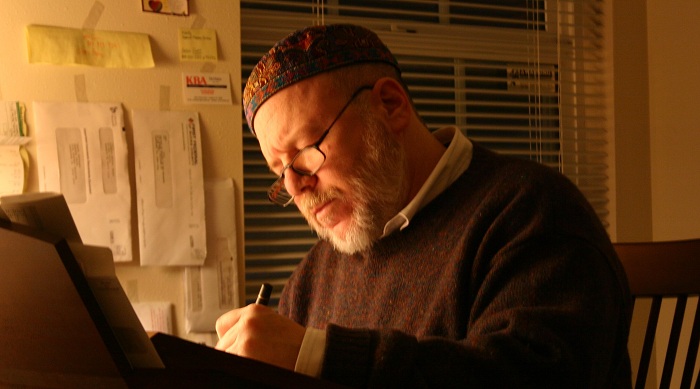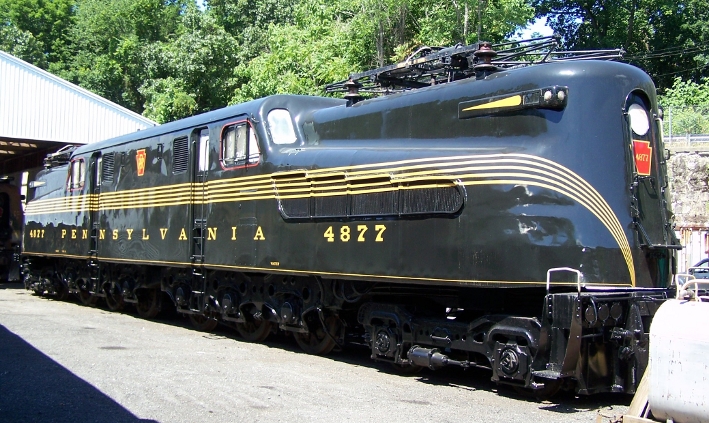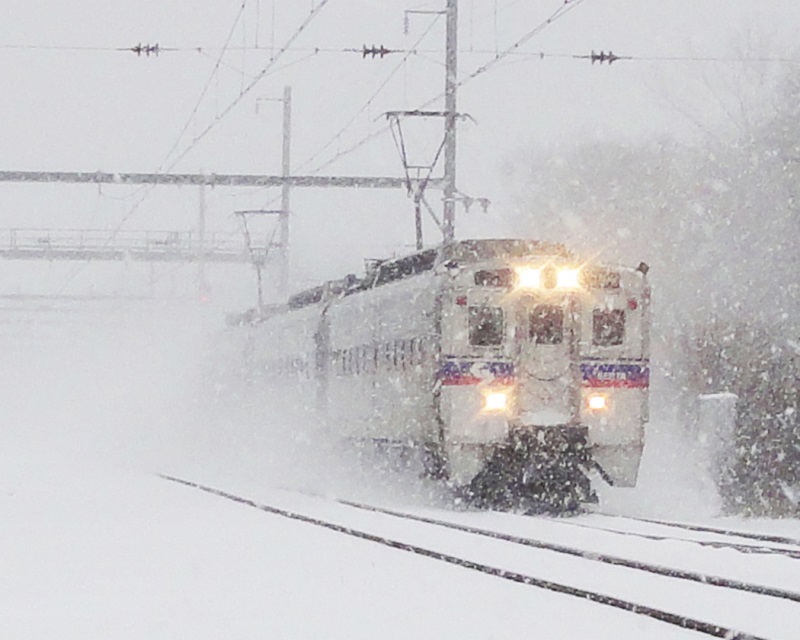 |
From the Night Factory
34. GG1
It was a summer night and the windows were opened. I was a young lad, given to being up all night even then. On quiet nights, when the traffic had ceased, I could hear the distant trains.
That night I heard a deep drone. It was persistent. It was not moving. I suspected it was a train, but why wasnít it moving? I straddled my bicycle and went in search of the source.
It was a broad sound; I could not pinpoint the direction. While the source of the noise was in fact only 3.3 miles distant, I meandered five miles trying to keep it growing louder. The hunt took me out of suburbia, across the four-lane U.S. Route 1 which constrained the spread of Levittown. Route 1 was lined with shops and dealerships, and the Langhorne Speedway, an almost perfect circle nicknamed ďThe Big Left TurnĒ. It is gone now. There was also the Roosevelt Drive-In Theater. It, too, is now gone.
At three oíclock in the morning, there was no traffic on Route 1. Still pursuing the incessant hum, I found myself on the north side of Route 1 and tracing a country road. What was the name of the small airport? Old Star Airport? They used to have airshows. Itís gone, too.
On the other side of Route 1 was countryside. I found myself narrowing my search, following my ears along Oxford Valley Road. The Oxford Valley Mall did not yet exist. The Sesame Place Amusement Park also did not yet exist; Sesame Street had yet to appear on television. I was alone, the only one awake among woods and fields, and I canít remember what my light source was for those dark roadways. Were there streetlights? Did my bike have a lamp? It was an adventure.
As I approached the source, I could feel the bass note of the beast reverberating in my chest. I had found the monster idling on the railroad track concealed in woods, where the tracks crossed Big Oak Road, the darkness lit by the monsterís monocular headlight. It was my introduction to the GG1.

The GG1 was an electric locomotive built by General Electric for the Pennsylvania Railroad. The big green brute was like Doctor Doolittleís Pushmi-Pullyu; it consisted of two fronts backed into each other, so the engine could run equally well in either direction. There were two separate cabs placed near together towards the middle, and extending out from each were long doglike snouts. Alongside the behemoth was its incongruous mahout, the engineer, inspecting the undercarriage. I parked my bicycle and cautiously approached the engineer.
He was surprised to see me, and might have been more surprised had he known how far I had travelled to see his trained beast. He was delighted by my interest and, to my amazement, he invited me to climb the ladder and see inside the locomotive. The ladder hugged the side of the hulking mass, a precarious straight climb, and felt higher as you rose than it seemed from the track bed. This was fun. But then it was like climbing into a mailbox.
The inside of the cab was not made for comfort. It was raw. Metal pipes and panels were all coated a generic battleship grey. Everything felt forced into this little room to be accessible to the engineer, but there was no interest in making the engineer cozy. It was a leftover space inside a big machine into which they could insert an insignificant human. The view ahead was through a tiny window and the locomotiveís snout presented a wall that blocked half the view. This was a machine, a relic of the industrial age.
In this other time, when I was a kid, I once or twice got invited into the cockpit of an airliner in flight, probably like a thousand other kids, to see the gadgetry and the pilotís view of airspace. Technology insulated the pilot. The complexity of flight was the planeís obedience to the pilot, who served as its brain. The locomotive was different. With just a few instrument to knock the creature about, you brought it into submission. It was never an extension of oneself. It was a separate entity that might charge away without you if you didnít watch it.
With my curiosity rewarded and the sky now turning pale with the light that precedes the sun, I said my thanks to the engineer and pedaled my bike home.
Fifty years later I am living in an apartment development less than a mile from that intersection of road and track where I confronted the GG1. This development wasnít here back then. It has only grown up in the last seven or eight years. The burdening population gets pushed by developers closer to railroad tracks and highways. Stepping out of the back of this building and there are woods that separate us from the tracks, a mere 330 feet away. In winter, without the filtering leaves, you can see the trains pass, the galloping commuters and the sluggish freights. At night, you only see their lights followed by massive shadows passing between the trunks of trees. With the freights in particular, you sense their weight and strength as they pull their long tails. It still excites me.
Railway tracks have been mysteries to me, coming and going places I canít follow because they are unassociated to roads. I know something about the tracks on the other side of the woods. I still think of them as the Reading Railroad. Ms Keogh, my more significant other, who came to live with me in Bucks County in 1983, thinks of them as the SEPTA R3 line. That very year CXS took ownership of the track and SEPTA became a tenant. SEPTA changed the R3 name in 2010 to the West Trenton Line. In fact, the track continues past the West Trenton Station and travels all the way to Newark. I know this because of Neil.
Two days a week, Ms Keogh and I volunteer to work at a small used bookstore in downtown Trenton, Classics Books, a community cornerstone in a city otherwise deprived of books. It is there that I have made friends with a regular visitor. Neil is an actuary for the state who often comes in during his lunch break to visit and talk religion, philosophy, mathematics, and everything else. Trim beard, white-haired and dignified, it is only this last week that I learned the genteel Neil was also a trainspotter. He was disappointed I didnít remember the number of the GG1.
Proximity with railroad tracks has reignited my interest in trains. I havenít given trains much thought since meeting the GG1. From Neil, I have learned about the second track. This one passes within 100 feet of the recycle bins and garbage compactor on the far other end of our development. Sometimes, at night, when I am disposing of our garbage, there is another monster lurking right there in the trees growling a bass note of potential power. Neil explained this track is the Trenton Cutoff, a low-grade line dedicated to freight, connecting New York City with Harrisburg, Pennsylvania while bypassing Philadelphia. Trains depart the primary tracks at the Morrisville Yard and make their way to Thorndale to rejoin them.
I donít expect I will become a trainspotter, but I am now fascinated with the arcane network that threads through my world. Having trains for neighbors has renewed my curiosity. It has presented itself as a subject for my photography. I have stood by the tracks that pass our development in order to photograph the commuter during a recent snowstorm.

We pass the Morrisville Yard every day we drive to the bookstore, but now I wish to visit it for a closer look. The Main Line, a suburban region of Philadelphia, is famous for the residences of the city's upper crust. I never knew, until now, that the Main Line takes its name from the old main line of the Pennsylvania Railroad, which begins in Philadelphia and heads west through Harrisburg, the state capital, to reach Pittsburgh. I have become interested with the vestiges of that once great railroad, the Pennsylvania Railroad, which used to be headquartered in Philadelphia.
There is a dark side, too, to the presence of this track. Ms Keogh and I have been stopped at crossings to watch as we waited for the freights to pass. From time to time, we have been seeing a new freight traversing these tracks that pass within 330 feet of our home, long arrays of ominous black tankers carrying crude oil, a virtual pipeline. We do not forget the Lac-Mťgantic derailment of last summer.
Mr Bentzman will continue to report here regularly about the events and concerns of his life. If you've any comments or suggestions, he would be pleased to hear from you.
Selected Suburban Soliloquies, the best of Mr Bentzman's earlier series of Snakeskin essays, is available as a book or as an ebook, from Amazon and elsewhere.
